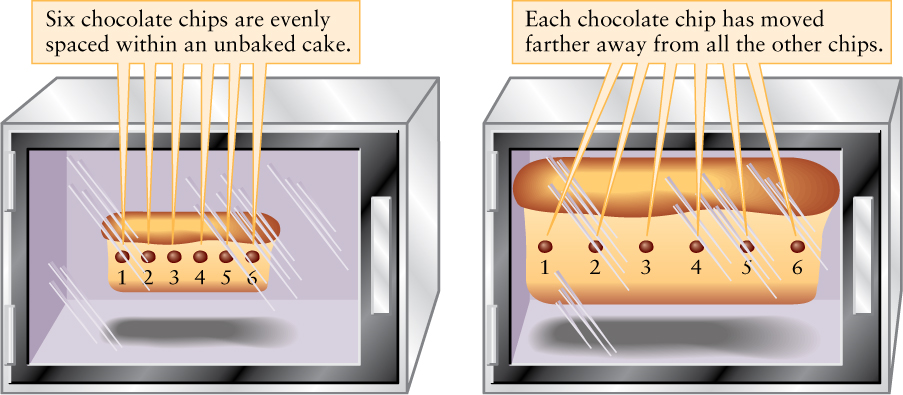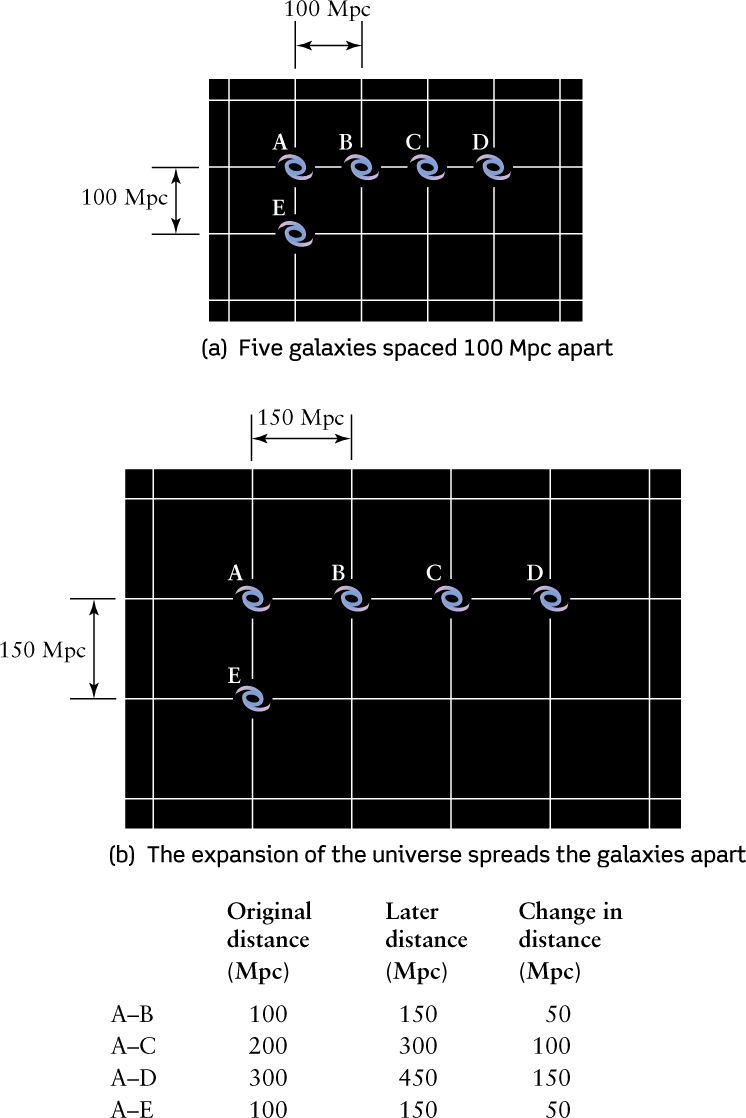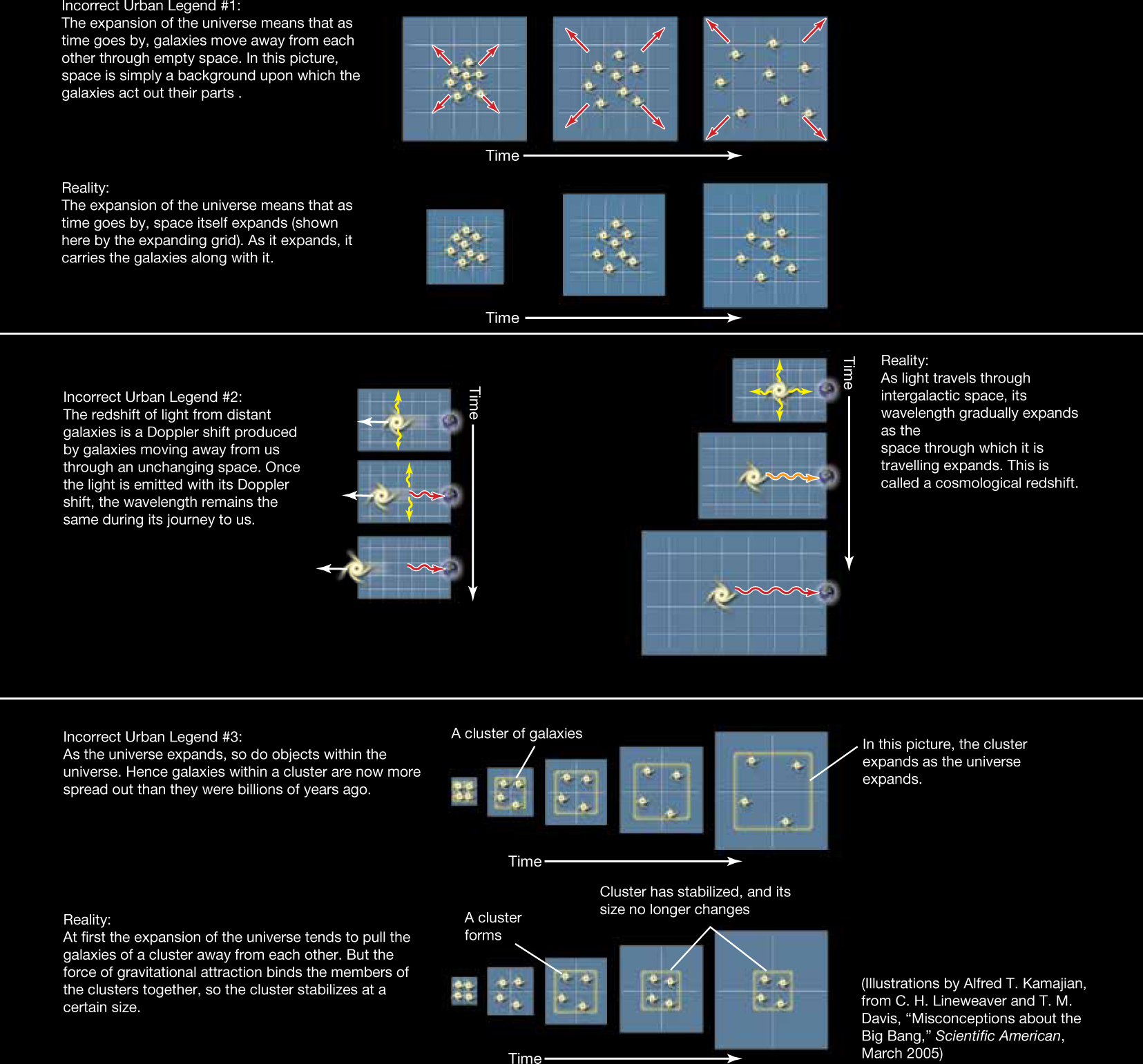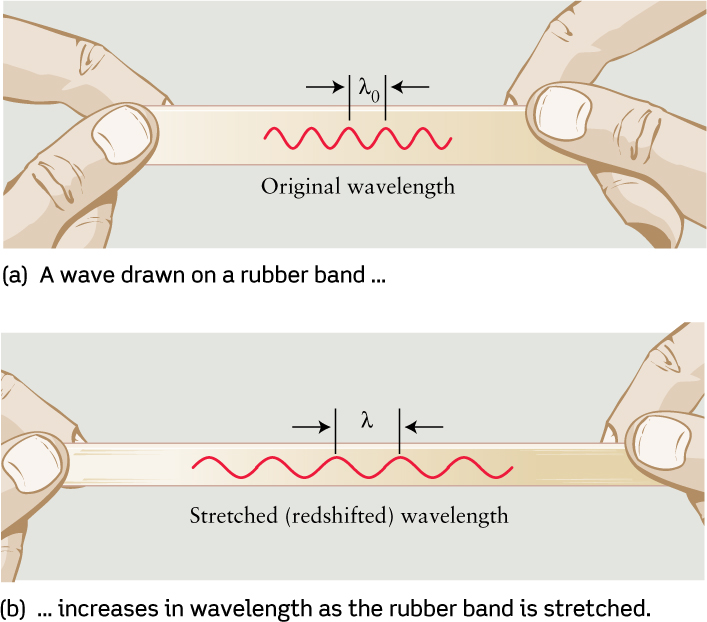25-2 The universe is expanding
 Hubble is usually credited with discovering that our universe is expanding. He found a simple linear relationship between the distances to remote galaxies and the redshifts of the spectral lines of those galaxies (review Section 23-5, especially Figure 23-16 and Figure 23-17). This relationship, now called the Hubble law, states that the greater the distance to a galaxy, the greater is the galaxy’s redshift. Thus, remote galaxies are moving away from us with speeds proportional to their distances. Now let us see how Hubble’s law reveals an expanding universe.
Hubble is usually credited with discovering that our universe is expanding. He found a simple linear relationship between the distances to remote galaxies and the redshifts of the spectral lines of those galaxies (review Section 23-5, especially Figure 23-16 and Figure 23-17). This relationship, now called the Hubble law, states that the greater the distance to a galaxy, the greater is the galaxy’s redshift. Thus, remote galaxies are moving away from us with speeds proportional to their distances. Now let us see how Hubble’s law reveals an expanding universe.
The Hubble Law and the Expanding Universe
The Hubble law can be stated as a very simple equation that relates the recessional velocity v of a galaxy to its distance d from Earth:
v = H0d
where H0 is the Hubble constant. Because remote galaxies are getting farther and farther apart as time goes on, astronomers say that the universe is expanding. We say these galaxies are in the Hubble flow.
ANALOGY
What does it actually mean to say that the universe is expanding? According to general relativity, space itself is not rigid. The amount of space between widely separated locations increases over time. A good analogy is that of baking a chocolate chip cake, as in Figure 25-2. As the cake expands during baking, the chocolate chips do not move through the cake but the amount of space between the chocolate chips gets larger and larger. In the same way, as the universe expands, galaxies in the Hubble flow do not move through space, but the amount of space between widely separated galaxies increases. The expansion of the universe is the expansion of space.

CAUTION!
It is important to realize that the expansion of the universe occurs primarily in the vast spaces that separate clusters of galaxies. Just as the individual chocolate chips in Figure 25-2 do not expand as the cake expands during baking, galaxies themselves do not expand. Einstein and others have established that an object that is held together by its own gravity, such as a galaxy or a cluster of galaxies, creates a region of nonexpanding space. Likewise, molecular forces, which are much stronger than gravity, prevent expansion. For example, Earth and your body, which are held together by molecular forces, are not getting any bigger. Only the distance between widely separated galaxies increases with time. This expansion actually creates space. The Cosmic Connections: “Urban Legends” about the Expanding Universe has more to say about several misconceptions concerning the expanding universe.
The Hubble law is a direct proportionality—that is, a galaxy twice as far away is receding from us twice as fast. This property is just what we would expect in an expanding universe. To see why this property results from uniform expansion, imagine a grid of parallel lines (as on a piece of graph paper) crisscrossing the universe. Figure 25-3a shows a series of such gridlines 100 Mpc apart, along with five galaxies labeled A, B, C, D, and E that happen to lie where gridlines cross. As the universe expands in all directions, the gridlines and the attached galaxies spread apart. (This is just what would happen if the universe were a two-dimensional rubber sheet that was being pulled equally on all sides. Alternatively, you can imagine that Figure 25-3a depicts a very small portion of the chocolate chip cake in Figure 25-2, with galaxies taking the place of chocolate chips.)

 The Expanding Universe and the Hubble Law (a) Imagine five galaxies labeled A, B, C, D, and E. At the time shown here, adjacent galaxies are 100 Mpc apart. (b) As the universe expands, by some later time the spacing between adjacent galaxies has increased to 150 Mpc. The table shows that the greater the original distance between galaxies, the greater the amount that distance has increased. This agrees with the Hubble law.
The Expanding Universe and the Hubble Law (a) Imagine five galaxies labeled A, B, C, D, and E. At the time shown here, adjacent galaxies are 100 Mpc apart. (b) As the universe expands, by some later time the spacing between adjacent galaxies has increased to 150 Mpc. The table shows that the greater the original distance between galaxies, the greater the amount that distance has increased. This agrees with the Hubble law.
COSMIC CONNECTIONS
“Urban Legends” about the Expanding Universe

Figure 25-3b shows the universe at a later time, when the gridlines are 50% farther apart (150 Mpc) and all the distances between galaxies are 50% greater than in Figure 25-3a. Imagine that A represents our Galaxy, the Milky Way. The table accompanying Figure 25-3 shows how far each of the other galaxies has moved away from us during the expansion: Galaxies A and B and galaxies A and E were originally 100 Mpc apart and have moved away from each other by an additional 50 Mpc; A and C, which were originally 200 Mpc apart, have increased their separation by an additional 100 Mpc; and the distance between A and D, originally 300 Mpc, has increased by an additional 150 Mpc. In other words, the increase in distance between any pair of galaxies is in direct proportion to the original distance; if the original distance is twice as great, the increase in distance is also twice as great.
To see what these distances tell us about the recessional velocities of galaxies, remember that velocity is equal to the distance moved divided by the elapsed time. (For example, if you traveled in a straight line for 360 kilometers in 4 hours, your velocity was (360 km)/(4 h) = 90 kilometers per hour.) Because the distance that each galaxy moves away from A during the expansion is directly proportional to its original distance from A, it follows that the velocity v at which each galaxy moves away from A is also directly proportional to the original distance d. This result is just the Hubble law, v = H0d.
CAUTION!
It may seem that if the universe is expanding, and if we see all the distant galaxies rushing away from us, then we must be in a special position at the very center of the universe. In fact, the expansion of the universe looks the same from the vantage point of any galaxy. For example, as seen from galaxy D in Figure 25-3, the initial distances to galaxies A, B, and C are 300 Mpc, 200 Mpc, and 100 Mpc, respectively. Between parts (a) and (b) of the figure, these distances increase by 150 Mpc, 100 Mpc, and 50 Mpc, respectively. So, as seen from D as well, the recessional velocity increases in direct proportion with the distance, and in the same proportion as seen from A. In other words, no matter which galaxy you call home, you will see all the other galaxies receding from you in accordance with the same Hubble law (and the same Hubble constant) that we observe from Earth.
Figure 25-2 also shows that the expansion of the universe looks the same from one galaxy as from any other. An insect sitting on any one of the chocolate chips would see all the other chips moving away. If the cake were infinitely long, it would not actually have a center; as seen from any chocolate chip within such a cake, the cake would extend off to infinity to the left and to the right, and the expansion of the cake would appear to be centered on that chip. Likewise, because every point in the universe appears to be at the center of the expansion, it follows that our universe has no center at all.
CAUTION!
“If the universe is expanding, what is it expanding into?” This commonly asked question arises only if we take our chocolate chip cake analogy too literally. In Figure 25-2, the cake (representing the universe) expands in three-dimensional space into the surrounding air. But the actual universe includes all space; there is no extra or additional space for the universe to expand into. Asking “What lies beyond the universe?” is like asking “Where on Earth is north of the North Pole?”—there just isn’t a place on Earth that this point could be.
The ongoing expansion of space explains why the light from remote galaxies is redshifted. Imagine light or a photon coming toward us from a distant galaxy. As the photon travels through space, the space is expanding, so the photon’s wavelength becomes stretched. When the photon reaches our eyes, we see an increased wavelength: The photon has been redshifted. The longer the photon’s journey, the more its wavelength will have been stretched along the way. Thus, photons from distant galaxies have larger redshifts than those of photons from nearby galaxies, as expressed by the Hubble law.
The redshifts of distant galaxies are not Doppler shifts; they are caused by the expansion of space itself
A redshift caused by the expansion of the universe is properly called a cosmological redshift. It is not the same as a Doppler shift. Doppler shifts are caused by an object’s motion through space, whereas a cosmological redshift is caused by the expansion of space (Figure 25-4).

In Hubble’s law, the original interpretation of redshifts was that they were due to Doppler shifts by receding galaxies, and this works because for small redshifts, the Doppler shift can account for the recession of galaxies in expanding space. However, the full properties of expanding space, described by Einstein’s general theory of relativity, must be taken into account for larger redshifts. In fact, at redshifts (z) greater than about z > 1.5, galaxies are observed with recessional velocities greater than the speed of light. While this would violate the laws of physics in a static universe, recessional speeds can exceed the speed of light in an expanding universe.
CONCEPT CHECK 25-2
Although nearly all distant galaxies have measureable redshifts, the relatively nearby Andromeda Galaxy exhibits an overall blue shift. What does this mean about the Andromeda Galaxy’s movement?
The spectral shift toward the shorter blue wavelengths means that the Andromeda Galaxy is moving toward our Milky Way Galaxy.
Cosmological Redshift and Lookback Time
We can calculate the factor by which the universe has expanded since some ancient time from the redshift of light emitted by objects at that time. As we saw in Section 24-5, redshift (z) is defined as

In this equation λ0 is the unshifted wavelength of a photon and λ is the wavelength we observe. For example, λ0 could be the wavelength of a particular emission line in the spectrum of light leaving a remote galaxy. As the galaxy’s light travels through space, its wavelength is stretched by the expansion of the universe. Thus, at our telescopes we observe the spectral line to have a wavelength λ. The ratio λ/λ0 is a measure of the amount of stretching. By rearranging terms in the preceding equation, we can solve for this ratio to obtain

For example, consider a galaxy with a redshift z = 3. Since the time that light left that galaxy, the universe has expanded by a factor of 1 + z = 1 + 3 = 4. In other words, when the light left that galaxy, representative distances between widely separated galaxies were only one-quarter as large as they are today. A representative volume of space, which is proportional to the cube of its dimensions, was only (1/4)3 = 1/64 as large as it is today. Thus, the density of matter in such a volume was 64 times greater than it is today.
If you know the redshift z of a distant object such as a remote galaxy, you can calculate that object’s recessional velocity v (see Box 23-2 for this calculation). Then, using the Hubble law, you can determine the distance d to that object if you know the value of the Hubble constant H0. This distance also tells you the lookback time of that object, that is, how far into the past you are looking when you see that object. For example, if the lookback time for a distant galaxy is a billion years, that means the light from the galaxy took a billion years to reach us, so we are seeing it as it was a billion years ago. The images that open this chapter show supernovae in distant galaxies with lookback times from 7.7 to 9.0 billion years.
Distances and lookback times determined in this way are somewhat uncertain, because there is some uncertainty in the value of the Hubble constant. Furthermore, as we will see in Section 25-8, the universe has not always expanded at the same rate. This variable rate of expansion means that the value of the Hubble constant H0 was different in the distant past. (In other words, the Hubble “constant” is not actually constant in time, but at a given time it is still constant throughout space.) Furthermore, the correct distance d to use in the Hubble law is not the distance at which we see the object, but rather the distance between us and the object now. This latter distance is larger because during the time that it takes light to reach us from a distant object, that object has moved farther away due to the expansion of the universe.
To avoid dealing with these uncertainties and complications, astronomers commonly refer to times in the distant past in terms of redshift rather than years. For example, instead of asking, “How common were quasars 5 billion years ago?,” an astronomer might ask, “How common were quasars at z = 1.0?” In this question, “at z = 1.0” is a shorthand way of saying “at the lookback time that corresponds to objects at z = 1.0.” We will use this terminology later in this chapter. Remember that the greater the redshift, the greater the lookback time, and hence the further back into time we are peering.
The Cosmological Principle
In cosmology, there is only one universe that we can observe. Unlike other sciences, we cannot carry out controlled experiments or even make comparisons between two similar systems, when the system is the universe itself. But then a question arises: Are we observing the universe from a special location, resulting in a unique, nonrepresentative appearance? Or would observers anywhere see a universe with the same properties on large scales? The answer to this question determines how we interpret Hubble’s law, because receding galaxies could be interpreted to mean that we are at the center of the universe. The idea that we are at the center of the universe was rejected, however, because it violates a cosmological extension of Copernicus’s argument that we do not occupy a special location in space. An expanding universe, on the other hand, has no center; at all locations in space, observers would see galaxies recede according to Hubble’s law.
When Einstein began applying his general theory of relativity to cosmology, he made a daring assumption: Over very large distances the universe is homogeneous, meaning that every region is the same as every other region, and isotropic, meaning that the universe looks the same in every direction. In other words, if you could stand back and look at a very large region of space, any one part of the universe would look basically the same as any other part, with the same kinds of galaxies distributed through space in the same way. The assumption that the universe is homogeneous and isotropic constitutes the cosmological principle. It gives precise meaning to the idea that we do not occupy a special location in space.
Models of the universe based on the cosmological principle have proven remarkably successful in describing the structure and evolution of the universe and in interpreting observational data. More recently, direct observations reveal a homogeneous and isotropic universe on the largest scales—a validation of the cosmological principle. A homogenous and isotropic universe is revealed in maps made of large-scale structure, as shown in Figure 23-23 and Figure 23-24. As we will see in Section 25-5, radiation left over from the Big Bang produces a similar result for the early universe.
CONCEPT CHECK 25-3
If we notice in the night sky that there are more stars along the Milky Way than in other regions of the sky, is this consistent or inconsistent with the cosmological principle?
The cosmological principle applies over very large regions of outer space; it does not apply to the distribution of stars in objects as small as a galaxy.
CALCULATION CHECK 25-1
What is the redshift z-value for a galaxy that has a galaxy spectral line shifted to 725.6 nm when a stationary object would emit the line at from 656.3 nm?
Because z = the change in wavelength (λ − λ0) divided by the original λ0, z = (725.6nm − 656.3nm) ÷ 656.3 nm = 0.11.
CALCULATION CHECK 25-2
What is the distance to a galaxy that is observed to have a recessional velocity of 10,000 km/s?
Hubble’s Law, v = H0d can be rearranged as d = v ÷ H0. Using H0 = 73 km/s/Mpc, d = v ÷ H0 = 10,000 km/s ÷ 73 km/s/Mpc = 137 Mpc (million parsecs).